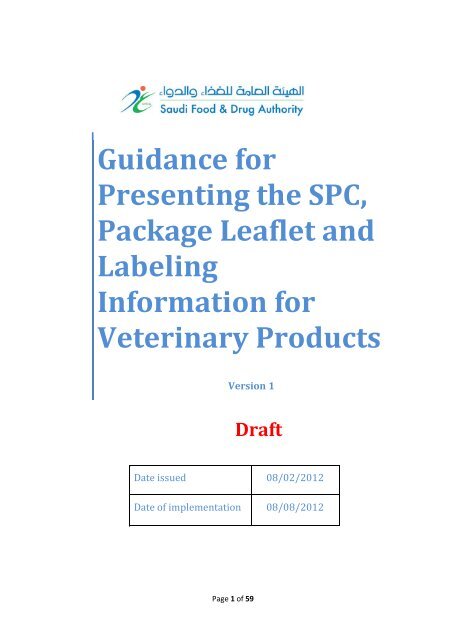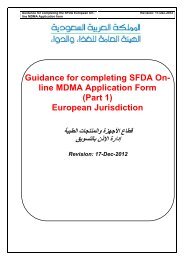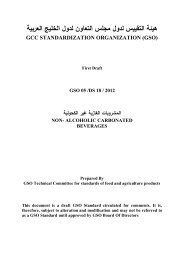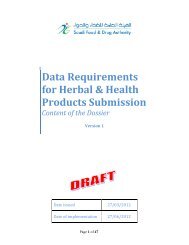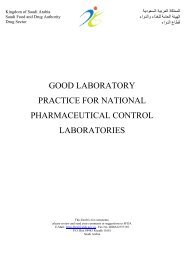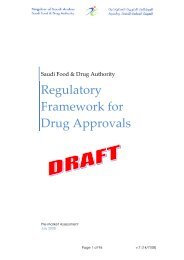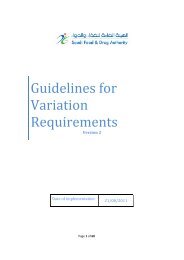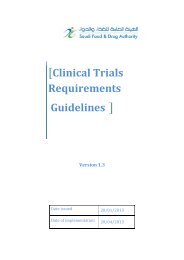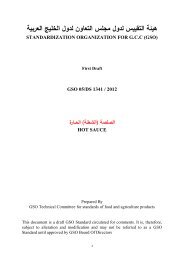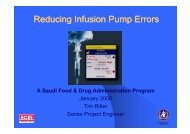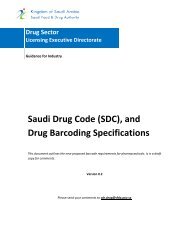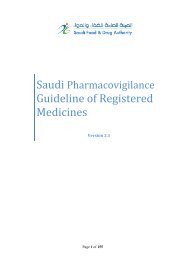Guidance for Presenting the SPC, Package Leaflet and Labeling ...
Guidance for Presenting the SPC, Package Leaflet and Labeling ...
Guidance for Presenting the SPC, Package Leaflet and Labeling ...
- No tags were found...
Create successful ePaper yourself
Turn your PDF publications into a flip-book with our unique Google optimized e-Paper software.
<strong>Guidance</strong> <strong>for</strong> <strong>Presenting</strong> <strong>the</strong> <strong>SPC</strong>,<strong>Package</strong> <strong>Leaflet</strong> <strong>and</strong> <strong>Labeling</strong>In<strong>for</strong>mation <strong>for</strong> Veterinary ProductsVersion 1Drug SectorSaudi Food & Drug AuthorityKingdom of Saudi ArabiaPlease visit SFDA’s website at http://www.sfda.gov.sa/En/Drug<strong>for</strong> <strong>the</strong> latest updatePage 2 of 59
Document ControlVersion Date Author(s) Comments1.0 8/03/2012Product Evaluation <strong>and</strong> St<strong>and</strong>ardsSetting DepartmentDraftPage 3 of 59
Introduction:This guideline is adapted from <strong>the</strong> EMEA Notice to applicants veterinary medicinalproducts, volume 6C.The document is intended to guide <strong>the</strong> applicants on how to present <strong>the</strong> requiredin<strong>for</strong>mation <strong>for</strong>:• Summary of Product Characteristics (<strong>SPC</strong>);• <strong>Package</strong> <strong>Leaflet</strong>;• <strong>Labeling</strong>.The <strong>SPC</strong> is <strong>the</strong> basis of in<strong>for</strong>mation <strong>for</strong> veterinary professionals on how to use <strong>the</strong>medicinal product safely <strong>and</strong> effectively. <strong>Package</strong> <strong>Leaflet</strong> shall be drawn up in accordancewith <strong>the</strong> <strong>SPC</strong>.This guideline provides advice on <strong>the</strong> principles of presenting in<strong>for</strong>mation. Applicantsshould maintain <strong>the</strong> integrity of each section of <strong>the</strong> document by only includingin<strong>for</strong>mation in each section, which is relevant to <strong>the</strong> section heading. However, someissues may need to be addressed in more than one section <strong>and</strong> in such situations <strong>the</strong>individual statements may cross refer to o<strong>the</strong>r sections when <strong>the</strong>se contain relevantadditional in<strong>for</strong>mation.When submitting a new application <strong>for</strong> registration, renewal or variation, <strong>the</strong> in<strong>for</strong>mationpresented by <strong>the</strong> applicant regarding <strong>the</strong> <strong>SPC</strong>, <strong>Package</strong> <strong>Leaflet</strong> <strong>and</strong> labeling must followthis guidance.Page 6 of 59
Summary of Product Characteristics (<strong>SPC</strong>)General considerations <strong>for</strong> <strong>the</strong> preparation of <strong>the</strong> <strong>SPC</strong>When preparing an <strong>SPC</strong>, it should be noted that <strong>the</strong> <strong>SPC</strong> is intended to provide detailedobjective in<strong>for</strong>mation on <strong>the</strong> conditions of authorization of a veterinary medicinal product.The <strong>SPC</strong> is not a promotional document, nor is it intended to constitute a summary of <strong>the</strong>evaluation of <strong>the</strong> medicinal product by <strong>the</strong> SFDA.It follows that all <strong>the</strong> statements contained in <strong>the</strong> <strong>SPC</strong> must be justified by <strong>the</strong> contents of<strong>the</strong> application dossier which is submitted to <strong>the</strong> SFDA. Statements of a promotionalnature such as “xx is <strong>the</strong> treatment of choice <strong>for</strong> y” are not acceptable. Moreover,extraneous in<strong>for</strong>mation such as <strong>the</strong> results of toxicity studies should not be included unlessnecessary to enable <strong>the</strong> practitioner to assess <strong>the</strong> benefits <strong>and</strong> risks of <strong>the</strong> use of <strong>the</strong>product in a particular case.Particular care should be taken to ensure that clear <strong>and</strong> unambiguous language is usedthroughout <strong>the</strong> <strong>SPC</strong>. Attention should be given to <strong>the</strong> clear definition of <strong>the</strong> scope of <strong>the</strong>indications, contraindications, precautions <strong>for</strong> use <strong>and</strong> warning statements to ensure that<strong>the</strong>se clearly identify <strong>the</strong> groups or sub-groups of animals concerned.Applicants should maintain <strong>the</strong> integrity of each section of <strong>the</strong> document by onlyincluding in<strong>for</strong>mation in each section, which is relevant to <strong>the</strong> section heading. However,some issues may need to be addressed in more than one section of <strong>the</strong> <strong>SPC</strong> (e.g.contraindications plus interactions). In such situations, <strong>the</strong> individual statements maycross-refer to o<strong>the</strong>r sections when <strong>the</strong>se contain relevant additional in<strong>for</strong>mation.A separate <strong>SPC</strong> should be completed per pharmaceutical <strong>for</strong>m, including all strengths ofeach pharmaceutical <strong>for</strong>m, if appropriate, <strong>and</strong> containing all pack-sizes related to <strong>the</strong>strength(s) <strong>and</strong> pharmaceutical <strong>for</strong>m concerned.St<strong>and</strong>ard statements are given in <strong>the</strong> template which must be used whenever <strong>the</strong>y areapplicable. If <strong>the</strong> applicant can justify <strong>the</strong> need to deviate from <strong>the</strong>se statements toaccommodate product-specific requirements, alternative or additional statements will beconsidered on a case-by-case basis.Page 7 of 59
Bracketing convention:{text}: In<strong>for</strong>mation to be filled in.: Text to be selected or deleted as appropriate.A. <strong>SPC</strong> – For Pharmaceutical <strong>and</strong> Immunological Veterinary MedicinalProducts1. Name of <strong>the</strong> veterinary medicinal product{(Invented) name of veterinary medicinal product strength pharmaceutical <strong>for</strong>m}Given in <strong>the</strong> following order: (invented) name (no ® symbols attached here orthroughout <strong>the</strong> text), strength (consistent with section 2 of <strong>the</strong> <strong>SPC</strong>), pharmaceutical<strong>for</strong>m “tablets” <strong>and</strong> “capsules” in <strong>the</strong> plural) <strong>and</strong> target animal species, if necessary , inorder to avoid any confusionE.g. {(Invented) name} 10 mg tablets <strong>for</strong> dogs{(Invented) name} 20 mg/ml solution <strong>for</strong> injection <strong>for</strong> dogsFor mock-ups <strong>and</strong> specimens, this in<strong>for</strong>mation may be presented on different lines oftext or in different font sizes if necessary, provided that <strong>the</strong> appearance of <strong>the</strong> name ispreserved as an integrated item.When selecting invented names, care should be taken to avoid <strong>the</strong> use of words orabbreviations, which may give rise to confusion.In those sections of <strong>the</strong> <strong>SPC</strong> in which full in<strong>for</strong>mation on <strong>the</strong> name of <strong>the</strong> medicinalproduct is specifically required, <strong>the</strong> name should include both <strong>the</strong> strength <strong>and</strong>pharmaceutical <strong>for</strong>m, even if <strong>the</strong>re is only one strength <strong>and</strong>/or pharmaceutical <strong>for</strong>m.However, when o<strong>the</strong>rwise referring to <strong>the</strong> medicinal product throughout <strong>the</strong> text of <strong>the</strong><strong>SPC</strong>, strength <strong>and</strong> pharmaceutical <strong>for</strong>m do not have to be mentioned in <strong>the</strong> name. TheInternational Non-proprietary Name (INN) or <strong>the</strong> usual common name of <strong>the</strong> activesubstance should be used when referring to properties of <strong>the</strong> active substance(s) ra<strong>the</strong>rthan those of <strong>the</strong> product. The use of pronouns is encouraged where it improves <strong>the</strong>Page 8 of 59
Qualitative compositionThe international non-proprietary name (INN) recommended by <strong>the</strong> World HealthOrganization should be used, accompanied by its salt, derivative or hydrate <strong>for</strong>m ifrelevant. If no INN exists, <strong>the</strong> Pharmacopoeial name should be used. If <strong>the</strong> substanceis not in <strong>the</strong> Pharmacopoeia, <strong>the</strong> usual common name should be used. In <strong>the</strong> absence ofa common name, <strong>the</strong> exact scientific designation should be given. Substances withoutan INN or an exact scientific designation should be described by a statement of how<strong>and</strong> from what <strong>the</strong>y were prepared. References to a pharmacopoeial quality should notbe included.Where <strong>the</strong> active substance is present in <strong>the</strong> <strong>for</strong>m of <strong>the</strong> parent molecule, <strong>the</strong> st<strong>and</strong>ardterminology should be used (e.g. dexamethasone).Where <strong>the</strong> active substance is present as a salt, derivative or hydrate, this should beclearly stated (e.g. dexamethasone acetate).For immunologicals, where <strong>the</strong> active substance is of a particular quality st<strong>and</strong>ard, <strong>for</strong>example selected mutants or marker virus, this should be indicated. Excipients shouldbe referred to by <strong>the</strong>ir recommended INN if one exists or by <strong>the</strong>ir Pharmacopoeialname.Quantitative compositionThe quantity of <strong>the</strong> active substance must be expressed per dosage, per unit volume, orper unit of weight.Where <strong>the</strong> active substance is present in <strong>the</strong> <strong>for</strong>m of a salt or hydrate, <strong>the</strong> quantitativecomposition should be expressed in terms of <strong>the</strong> mass (or biological activity inInternational (or o<strong>the</strong>r) Units where appropriate) of <strong>the</strong> active entity or entities (base,acid or anhydrous material) in <strong>the</strong> molecule (e.g. X mg levamisole as levamisolesulphate).However, in <strong>the</strong> cases of older compounds which have traditionally been expressed in<strong>the</strong> <strong>for</strong>m of a salt or hydrate, it may in some cases be appropriate to indicate <strong>the</strong>quantitative composition in terms of both <strong>the</strong> parent molecule <strong>and</strong> <strong>the</strong> salt (e.g. X mgPage 10 of 59
levamisole equivalent to Y mg levamisole sulfate)In <strong>the</strong> case of unit dose preparations, <strong>the</strong> quantitative composition should be stated perunit dose (e.g. X mg per tablet; Y mg per ampoule). In o<strong>the</strong>r cases, <strong>the</strong> quantitativecomposition should be stated in terms of mg per g or mg per ml. When <strong>the</strong> product is apowder to be reconstituted prior to administration, <strong>the</strong> quantity per ml afterreconstitution should be stated.For immunologicals, <strong>the</strong> biological activity, <strong>the</strong> titre or <strong>the</strong> potency of <strong>the</strong> activesubstance should be described in international or o<strong>the</strong>r units <strong>and</strong> expressed per dose. Ininactivated vaccines <strong>the</strong> titre be<strong>for</strong>e inactivation is not acceptable. The compositionshould be given in terms of minimum quantities per dose <strong>and</strong>, if appropriate withmaximum quantities per dose <strong>and</strong> an indication of <strong>the</strong> nature of a single dose (e.g. volume).Active substance:Full details of <strong>the</strong> qualitative <strong>and</strong> quantitative composition in terms of activesubstances should be provided. Expressed per dosage unit or according to <strong>the</strong> <strong>for</strong>m ofadministration <strong>for</strong> a given volume or weight, using <strong>the</strong>ir INN or common names. Theuse of “%”, ppm or ppb as a strength should be avoided.]For salt/ester:E.g.:{quantity of active moiety} as {salt/ester}or{quantity of active moiety} equivalent to {quantity of salt/ester}5 mg {X} as {Y}8 mg {X} equivalent to 10 mg {Y}[E.g. Aluminum gels or salts, mineral or vegetable oil]Knowledge of which is essential <strong>for</strong> proper administration of <strong>the</strong> veterinary medicinalproduct, e.g . Preservatives such as <strong>for</strong>maldehyde or thiomersal.]Page 11 of 59
[For immunologicals, traces of antibiotics <strong>and</strong>/or o<strong>the</strong>r substances used in productionof vaccines not present in sufficient quantities to have a pharmacological effect shouldnot be included in <strong>the</strong> <strong>SPC</strong>]3. Pharmaceutical <strong>for</strong>mThe term used in this section should be <strong>the</strong> same as <strong>the</strong> term used in section 1.[Include here a description of <strong>the</strong> visual appearance of <strong>the</strong> product pharmaceutical<strong>for</strong>m as marketed e.g. shape, texture, colour, imprint, including in<strong>for</strong>mation on pH <strong>and</strong>osmolarity as required. In case of vaccines intended <strong>for</strong> reconstitution, <strong>the</strong> appearanceof <strong>the</strong> product be<strong>for</strong>e reconstitution should be stated here]Examples:-‘Tablet.White, circular flat bevelled-edge tablets marked ‘100’ on one side.’-“Solution <strong>for</strong> injection.Pale yellow, clear solution <strong>for</strong> injection, pH 7.0”If <strong>the</strong> product is not presented in <strong>the</strong> final pharmaceutical <strong>for</strong>m intended <strong>for</strong>administration to animals, <strong>the</strong> final pharmaceutical <strong>for</strong>m should also be stated, e.g.“powder <strong>and</strong> solvent <strong>for</strong> solution <strong>for</strong> injection”.In case of tablets, designed with a score line, a statement should be given whe<strong>the</strong>r ornot reproducible halfing of <strong>the</strong> tablets has been shown.Examples:-“The tablets can be divided into equal halves”.-“The scoreline is intended to facilitate ease of swallowing <strong>and</strong> not to divide intoequal doses.”4. Clinical particulars4.1 Target species[Including any sub-category; indicate species in singular or plural]Page 12 of 59
4.2 Indications <strong>for</strong> use, specifying <strong>the</strong> target speciesThe indications should be clearly defined <strong>for</strong> <strong>the</strong> target species. It should be clearlystated whe<strong>the</strong>r <strong>the</strong> treatment is <strong>for</strong> prophylactic, <strong>the</strong>rapeutic or diagnostic purposes.[For immunologicals, <strong>the</strong> indications should be clearly defined <strong>for</strong> <strong>the</strong> target species<strong>and</strong> should be substantiated by data in <strong>the</strong> dossier.The indications may be considered as <strong>the</strong> general claims <strong>for</strong> <strong>the</strong> immunologicalveterinary medicinal products. It gives <strong>the</strong> intention of <strong>the</strong> use of <strong>the</strong> immunologicalveterinary medicinal product. One or more of <strong>the</strong> following st<strong>and</strong>ard text <strong>and</strong> wordingshould be used, as appropriate.For active immunization or passive immunization of target species to:- Prevent mortality, clinical signs <strong>and</strong>/or lesions of <strong>the</strong> disease;- Prevent infection;- Reduce mortality, clinical signs <strong>and</strong>/or lesions of <strong>the</strong> disease;- Reduce infection.In addition to <strong>the</strong> indications, <strong>the</strong> onset <strong>and</strong> duration of immunity of <strong>the</strong>immunological veterinary medicinal product should be specified, if appropriate.Where appropriate, fur<strong>the</strong>r in<strong>for</strong>mation on <strong>the</strong> protection that can be expected from <strong>the</strong>use of <strong>the</strong> immunological veterinary medicinal product may be included.4.3 Contraindications[Do not specify species which are not included in <strong>the</strong> target species, unless studies orknowledge indicate severe toxicity; non-indications (e.g. “this veterinary medicinalproduct is not indicated <strong>for</strong>...”) should not be mentioned]Situations, which arise from a set of circumstances where <strong>the</strong> veterinary medicinalproduct must not be used <strong>for</strong> target animal safety reasons, i.e. absolutecontraindications, are <strong>the</strong> subject of this section. Contraindications may be linked witha target species or a sub-group of <strong>the</strong> target species, <strong>the</strong> administration of <strong>the</strong> productby a particular route or with administration in conjunction with o<strong>the</strong>r products.Fur<strong>the</strong>rmore, particular clinical diagnoses, concomitant diseases, age or sex mayPage 13 of 59
In<strong>for</strong>mation could include recommendations on <strong>the</strong> h<strong>and</strong>ling of animals, <strong>the</strong> properuse of <strong>the</strong> product or any o<strong>the</strong>r impact on <strong>the</strong> efficacy of <strong>the</strong> product.Additionally it is to warn prescribers of possibilities of modifications of <strong>the</strong> efficacyprofile of <strong>the</strong> product, which may arise in particular situations such as very old or veryyoung animals.Description should be made under which conditions <strong>the</strong> veterinary medicinal productmay be recommended <strong>for</strong> use in such groups provided <strong>the</strong> special precautions arefollowed. Situations in which use of <strong>the</strong> medicinal product is absolutelycontraindicated should be mentioned under section 4.3. only <strong>and</strong> is not to be repeatedin this section.Descriptions of warning <strong>and</strong> precautions regarding pregnancy, lactation or lay <strong>and</strong>o<strong>the</strong>r aspects of interactions should be dealt with in sections 4.7 <strong>and</strong> 4.8 respectively.Examples:- Limitations of use, if adequate:“Although <strong>the</strong> product may be safely administered to… with …, it has no<strong>the</strong>rapeutic effect against …; or“The efficacy of … has not been established in dogs weighing less than … orunder …of age”.- In<strong>for</strong>mation about dose or duration:“A second injection must not be given, even if clinical signs recur…”.- General recommendations <strong>for</strong> <strong>the</strong> proper use <strong>and</strong> about h<strong>and</strong>ling, if appropriate:“Animals with acute infections <strong>and</strong> severely reduced feed intake should be treatedwith a suitable injection product first”.- Impact on efficacy:“Frequent shampooing or immersion of <strong>the</strong> animal in water after treatment mayreduce <strong>the</strong> efficacy of <strong>the</strong> product” or“Animals may be ba<strong>the</strong>d xx hours after treatment without loss of efficacy”.In<strong>for</strong>mation on resistance should be included in this section, if applicable.Page 15 of 59
animals with renal or hepatic impairment (including <strong>the</strong> degree of impairment,such as mild, moderate or severe) or cardiac disease (including <strong>the</strong> severity of <strong>the</strong>condition) or sensitive sub-populations e.g. ivermectin sensitive collies.Examples:- “Special care should be taken when administering <strong>the</strong> product to animals with, since ….”- “Treated animals should be monitored <strong>for</strong> …”- “ may occur when administering <strong>the</strong> product to , in this case treatments should be < discontinued or doseshould be reduced>.- Any measures which can be taken to identify animals at risk <strong>and</strong> to prevent <strong>the</strong>occurrence, or to detect early <strong>the</strong> onset or worsening of conditions. Also, anysafety measures to minimize impact of <strong>the</strong> treatment to untreated animals shouldbe mentioned.- Where appropriate, in<strong>for</strong>mation may also be provided about possible risksresulting from <strong>the</strong> off-label use of <strong>the</strong> product.Descriptions of warning <strong>and</strong> precautions regarding pregnancy <strong>and</strong> lactation <strong>and</strong> o<strong>the</strong>raspects of interactions should be dealt with in sections 4.7 (Use during pregnancy,lactation or lay) <strong>and</strong> 4.8 (Interactions) respectively.Descriptions on general in<strong>for</strong>mation <strong>for</strong> instance on h<strong>and</strong>ling <strong>and</strong> directions <strong>for</strong> properuse concerning <strong>the</strong> mode of administration should be dealt with in section 4.9(Amounts to be administered) with cross reference to section 4.4 (Special warnings)e.g. “Do not administer more than 10 ml in each site of injection”.Do not use chlorinated water” <strong>for</strong> immunologicals.[Actions necessary to avoid pathogenic agents spreading from <strong>the</strong> vaccinate to ei<strong>the</strong>rnon-target categories of <strong>the</strong> same species or non-target species (<strong>for</strong> immunologicals.).]Page 17 of 59
{Species} <strong>and</strong> unvaccinated {species} in contact with vaccinated {species} mayreact to <strong>the</strong> vaccine strain, presenting clinical signs such as ….>[Any warnings necessary <strong>for</strong> excipients or residues from <strong>the</strong> manufacturing process.]ii. Special precautions to be taken by <strong>the</strong> person administering <strong>the</strong> medicinalproduct to animalsRisks resulting from <strong>the</strong> nature of <strong>the</strong> product, its preparation <strong>and</strong> use <strong>and</strong> of any risksresulting from <strong>the</strong> particular characteristics of <strong>the</strong> user should be stated here.Possible hypersensitivity reactions in <strong>the</strong> user to any of <strong>the</strong> excipients or residues from<strong>the</strong> manufacturing process should be included.Example:- People with known hypersensitivity to xx should If applicable, in<strong>for</strong>mation should also be given <strong>for</strong> persons in close contact to <strong>the</strong>treated animal e.g. animal owner, children, immuno-compromised persons, <strong>and</strong>pregnant women.Example:- Women of child-bearing potential should avoid contact with, or wear disposablegloves when administering, <strong>the</strong> product.Recommendations should be given to minimize <strong>the</strong> exposure of <strong>the</strong> user duringadministration or preparation of <strong>the</strong> product <strong>for</strong> administration.Page 18 of 59
Safety phrases given in international legislation should be used where possible.<strong>Guidance</strong> on action to be taken following accidental contact should also be given,where necessary..[If <strong>the</strong> product contains mineral oil:]Page 19 of 59
[O<strong>the</strong>r precautions regarding impact on <strong>the</strong> environment, or chemical reactions of<strong>the</strong> product with furniture or clo<strong>the</strong>s.]Examples:- This product is highly flammable. Keep away from heat, sparks, open flame oro<strong>the</strong>r sources of ignition.- Do not allow treated animals to swim in water courses until at least … hours/daysafter administration.[The following statements, which are relevant only <strong>for</strong> <strong>the</strong> product label <strong>and</strong> packageleaflet, should not be included in <strong>the</strong> <strong>SPC</strong>:‘For veterinary use only.’‘Keep out of reach <strong>and</strong> sight of children.’]4.6 Adverse reactions (frequency <strong>and</strong> seriousness)[By target species if more than one. Only include <strong>the</strong> adverse drug reactions (ADRs),which are those effects where a direct causal relationship between <strong>the</strong> effects <strong>and</strong> <strong>the</strong>treatment has been established]This section should include in<strong>for</strong>mation on adverse drug reactions attributed to <strong>the</strong>product when used as recommended. The reactions listed should be based on anassessment of all observed adverse events <strong>and</strong> all facts relevant to <strong>the</strong>ir causality,severity <strong>and</strong> frequency. The main adverse reactions in <strong>the</strong> target species should bePage 20 of 59
included in <strong>the</strong> <strong>SPC</strong>, if <strong>the</strong>y are at least possibly causally related, based <strong>for</strong> example on<strong>the</strong>ir comparative incidence in clinical trials, or on findings from epidemiologicalstudies <strong>and</strong>/or on an evaluation of causality from individual reports. Adverse events,without at least a suspected causal relationship, should not be listed in <strong>the</strong> <strong>SPC</strong>. Datacan be derived ei<strong>the</strong>r from data submitted in an application dossier or from postauthorizationpharmacovigilance reports.This section should also include in<strong>for</strong>mation about any action that may be taken by <strong>the</strong>animal owner or <strong>the</strong> veterinarian in case of adverse reactions, <strong>for</strong> example immediatecessation of treatment or emergency resuscitation. If <strong>the</strong>re is a need <strong>for</strong> awareness ofclinical signs representing early warning of a serious adverse reaction, a statementshould be included. Any need <strong>for</strong> specific clinical or laboratory monitoring should bestated.Claims regarding <strong>the</strong> absence of specific adverse reactions, statements on lack of proofof causal association or comparative frequency statements o<strong>the</strong>r than those describedbelow should not be included in this section.In order to provide clear <strong>and</strong> readily accessed in<strong>for</strong>mation, <strong>the</strong> section should bestructured according to <strong>the</strong> following recommendations:a) Description of <strong>the</strong> adverse reaction(s)The in<strong>for</strong>mation in this section must be consistent with <strong>the</strong> figures presented <strong>and</strong>should not contain general statements such as "well tolerated".The following in<strong>for</strong>mation should be provided <strong>for</strong> each adverse reaction: a briefdescription of <strong>the</strong> nature of <strong>the</strong> reaction, <strong>the</strong> duration, reversibility <strong>and</strong> intensity of<strong>the</strong> reactions, <strong>the</strong> frequency of <strong>the</strong> reaction experienced in treated animals <strong>and</strong> anyeffect on <strong>the</strong> general state of health of <strong>the</strong> animal. In addition, it should beindicated whe<strong>the</strong>r certain species or breeds or types of individual are moresusceptible to <strong>the</strong> undesirable effect concerned, or whe<strong>the</strong>r it is more frequentunder certain types of husb<strong>and</strong>ry conditions.All adverse reactions should be ranked in “frequency groupings” with <strong>the</strong> mostfrequently occurring reactions listed first, using <strong>the</strong> following convention:Page 21 of 59
Adverse reactionVery commonCommonUncommonRareVery rareIncidencemore than 1 in 10 animals displaying adverse reaction(s)during <strong>the</strong> course of one treatmentmore than 1 but less than 10 animals in 100 animalsmore than 1 but less than 10 animals in 1,000 animalsmore than 1 but less than 10 animals in 10,000 animalsless than 1 animal in 10,000 animals, including isolated reportsMore precise figures on <strong>the</strong> frequency of adverse reactions from clinical trials, e.g.XX% animals, are generally of limited value under conditions of market use <strong>and</strong>should only be included when it is of particular relevance to <strong>the</strong> animal owner oruser of <strong>the</strong> product <strong>and</strong>/or prescriber to be in<strong>for</strong>med of certain risks. In <strong>the</strong>se casesit is preferable that <strong>the</strong> data should be based on pooled study results <strong>and</strong>/or largestudies per<strong>for</strong>med under actual market conditions <strong>and</strong> should refer to adversereactions, not to unrelated adverse events.This in<strong>for</strong>mation can be presented in tabular <strong>for</strong>mat. Examples of acceptablestatements are given below:- “Commonly reported adverse reactions are gastrointestinal signs such asdiarrhoea”.- “Adverse reactions are rare (
4.7 Use during pregnancy, lactation or layIn order to ensure <strong>the</strong> safe use of <strong>the</strong> product, <strong>the</strong> user must be in<strong>for</strong>med of <strong>the</strong>recommendations regarding <strong>the</strong> use of <strong>the</strong> product in pregnant/lactating animals orlaying birds. In<strong>for</strong>mation about use of <strong>the</strong> product during pregnancy or lactation mayhave been provided in <strong>the</strong> sections dealing with contraindications or specialprecautions <strong>for</strong> use. In such cases, a cross-reference to <strong>the</strong> relevant section will besufficient. In<strong>for</strong>mation on <strong>the</strong> reasons <strong>for</strong> <strong>the</strong> relevant recommendation should alwaysbe given.In <strong>the</strong> absence of data, <strong>the</strong> use of this veterinary products is not recommended.In <strong>the</strong> case where reproductive toxicity studies have shown evidence of teratogenic,foetotoxic or maternotoxic effects in <strong>the</strong> target species or in o<strong>the</strong>r animal species, <strong>the</strong>applicant should give fur<strong>the</strong>r in<strong>for</strong>mation.Examples< Can be used during pregnancy> (if <strong>the</strong> safety on pregnant animals has been shown in<strong>the</strong> target species). because…” (if adversereactions have been shown during pregnancy with <strong>the</strong> recommended dose in <strong>the</strong> targetspecies, a case by case evaluation is needed <strong>and</strong> depending on <strong>the</strong> type of reaction).Page 23 of 59
The tolerance of <strong>the</strong> product in lactating animals <strong>and</strong> suckling off-spring should beaddressed here. In<strong>for</strong>mation in relation to consumer safety i.e. consequences of residues<strong>for</strong> <strong>the</strong> use of milk <strong>for</strong> human consumption should be given in section 4.11 (Withdrawalperiod).Where possible, in<strong>for</strong>mation on excretion of <strong>the</strong> active substance <strong>and</strong>/or its metabolite(s)in milk should be given. Where relevant, recommendation as to whe<strong>the</strong>r to stop orcontinue to feed (new-born) animals with milk obtained from <strong>the</strong> mo<strong>the</strong>r should be given,<strong>and</strong> <strong>the</strong> reason <strong>for</strong> <strong>the</strong> recommendation should be stated.Examples: (If <strong>the</strong> safe consumption of milk obtained from treatedanimals has been shown in <strong>the</strong> off spring in <strong>the</strong> target animal)., because” or “New born calves.. should not befed with milk from <strong>the</strong> treated animals, because…” (If adverse reactions have been shownin <strong>the</strong> off spring consuming milk from treated animals).For chicken/avian products, it should be indicated if <strong>the</strong> product is unsuitable <strong>for</strong> layingbirds.Example:- “Do not use in breeding birds <strong>and</strong>/or within xx weeks be<strong>for</strong>e <strong>the</strong> onset of <strong>the</strong> layingperiod”.If <strong>the</strong> product is not <strong>for</strong> use in laying birds <strong>the</strong> prohibition of use is given in section4.4. In<strong>for</strong>mation about <strong>the</strong> consequences of residues <strong>for</strong> <strong>the</strong> use of eggs <strong>for</strong> humanconsumption should be given in section 4.11. Withdrawal period.Page 24 of 59
The following st<strong>and</strong>ard phrase should be used when applicable:“Do not use inbreeding animals”.In<strong>for</strong>mation regarding fertility in both males <strong>and</strong> females should be given in sections4.3 (Contraindications), 4.4 (Special warnings) or 4.6 (Adverse reactions), asappropriate.4.8 Interaction with o<strong>the</strong>r medicinal products <strong>and</strong> o<strong>the</strong>r <strong>for</strong>ms of interaction [if appropriate] [if appropriate. For pharmaceuticals] [For immunologicals][Where safety <strong>and</strong> efficacy data are available <strong>for</strong> use of <strong>the</strong> products with o<strong>the</strong>rs <strong>the</strong>following statements are applicable:When <strong>the</strong> vaccines can be used on <strong>the</strong> same day:[For immunologicals][In <strong>the</strong> case of products administered parenterally, <strong>the</strong> products should be given atdifferent sites].When <strong>the</strong> vaccines can be used concurrently but not on <strong>the</strong> same day: [For immunologicals][The X number of days/weeks <strong>and</strong> <strong>the</strong> references to be<strong>for</strong>e or after are based on <strong>the</strong>data presented by <strong>the</strong> applicant in <strong>the</strong> marketing authorization file. They correspond toPage 25 of 59
<strong>the</strong> minimum time between administrations <strong>for</strong> which compatibility data have beensubmitted].[In addition to <strong>the</strong> above statements, to reflect <strong>the</strong> absence of in<strong>for</strong>mation on <strong>the</strong> safety<strong>and</strong> efficacy of <strong>the</strong> association with any o<strong>the</strong>r vaccines, <strong>the</strong> following wording shouldalso be included:] [For immunologicals]4.9 Amount(s) to be administered <strong>and</strong> administration routeInclude in<strong>for</strong>mation on <strong>the</strong> posology <strong>and</strong> method of administration. Posology: targetgroups to be specified, e.g. cattle less than 1 year of age. Method of administration:directions <strong>for</strong> proper use by healthcare professionals or by <strong>the</strong> farmer or owner <strong>and</strong>mixing instructions, if appropriate. Fur<strong>the</strong>r practical details <strong>for</strong> <strong>the</strong> farmer or ownercan be included in <strong>the</strong> package leaflet or, in its absence, on <strong>the</strong> label.]The dosage has to be specified <strong>for</strong> each target species, route of administration <strong>and</strong>indication.The dosage should be given per kg bodyweight (BW) in <strong>the</strong> first place, whereappropriate, as well as in terms of <strong>the</strong> amount to be administered to <strong>the</strong> animal (e.g. mlor mg/xx kg BW).The dosage should be expressed in terms of a veterinary medicinal product (e.g. byunit doses or by a volume of solution administered to <strong>the</strong> animal). Whenever a titre isexpressed in terms of infectious dose <strong>the</strong> wording should be cell culture infectiousdose (CCID 50%) <strong>and</strong> egg infectious dose. O<strong>the</strong>r terms can be added in order to guide<strong>for</strong> proper use of <strong>the</strong> product. International System (SI) units should be used. Thefrequency/interval <strong>and</strong> duration of administration should be specified in hours, days,weeks or months. [For immunologicals].The method, including route <strong>and</strong> site of administration <strong>and</strong> directions <strong>for</strong> proper use by<strong>the</strong> veterinarian, farmer or owner should be given. Any special equipment needed <strong>for</strong>Page 26 of 59
administration of <strong>the</strong> product should be mentioned. Where <strong>the</strong> product is to beadministered via <strong>the</strong> feed or water, any dosage adjustment <strong>for</strong> inappetent animalsshould be specified, if justified from <strong>the</strong> data available.O<strong>the</strong>r terms can be added in order to provide guidance on <strong>the</strong> proper use of <strong>the</strong>product. International System (SI) units should be used. The frequency <strong>and</strong> duration oftreatment should be specified in hours, days or weeks.For products to be administered via drinking water, important additional in<strong>for</strong>mationshould be added here:- “Medicated drinking water should be refreshed or replaced every “xx” hours.”For premixes <strong>for</strong> medicated feeding stuff, clear instructions <strong>for</strong> <strong>the</strong> proper preparationof <strong>the</strong> medicated feed e.g. pelleting instructions <strong>and</strong> mixing equipment, <strong>and</strong> <strong>the</strong> amountof premix <strong>for</strong> <strong>the</strong> incorporation should be provided. Also, in<strong>for</strong>mation on <strong>the</strong> feedingstuff(s) to be used should be included. If necessary, <strong>the</strong> use of a pre-mixture should berecommended.For products to be reconstituted, in<strong>for</strong>mation on <strong>the</strong> solvent to use <strong>and</strong> its volumeshould be given.[In case of vaccines intended <strong>for</strong> reconstitution, a visual description of <strong>the</strong> reconstitutedvaccine should be included here, e.g.: ]4.10 Overdose (symptoms, emergency procedures, antidotes), if necessaryThe purpose of overdose studies is to detect signs of possible adverse reactions <strong>and</strong> toidentify <strong>the</strong> dose at which <strong>the</strong>y occur, in order to establish a safety margin.Signs observed at higher dose levels than <strong>the</strong> recommended one should be mentioned.If no clinical signs were observed this should be mentioned as well. The followingin<strong>for</strong>mation should be provided, if available:- Clinical signs, nature, evolution, seriousness, duration. It should also be indicatedat what doses <strong>the</strong> overdosage signs were observed.- Available symptomatic treatments.Page 27 of 59
- Emergency procedures.- Antidote(s).4.11 Withdrawal period(s)The withdrawal period is defined as <strong>the</strong> period between <strong>the</strong> last administration of <strong>the</strong>veterinary medicinal product to animals <strong>and</strong> <strong>the</strong> production of foodstuffs from suchanimals. Where all foodstuffs may be used <strong>for</strong> human consumption during <strong>the</strong>treatment period <strong>and</strong> immediately after <strong>the</strong> last administration of a veterinarymedicinal product, a withdrawal of “zero days” should be indicated.If necessary, withdrawal periods should be stated <strong>for</strong> meat <strong>and</strong> offal, milk, or eggs.Withdrawal periods should be indicated in whole days, using Arabic numerals, except<strong>for</strong> milk withdrawal periods, which may be more appropriately expressed in wholehours. A zero withdrawal period should be expressed as ‘Zero hours/days’.However, <strong>for</strong> fish, <strong>the</strong> withdrawal period should be stated in degree-days. The numberof degree-days is divided by <strong>the</strong> average water temperature, in °C, to give <strong>the</strong>withdrawal period in days.When expressing <strong>the</strong> withdrawal period, <strong>the</strong> method of treatment must be taken intoaccount:- In <strong>the</strong> case of single administration only, <strong>the</strong> withdrawal period starts from <strong>the</strong>time of treatment.- In <strong>the</strong> case of two or more administrations, <strong>the</strong> time of <strong>the</strong> last treatment is definedas <strong>the</strong> start of <strong>the</strong> withdrawal period.- If a product is removed at <strong>the</strong> end of <strong>the</strong> treatment (e.g. implants), <strong>the</strong> time of <strong>the</strong>removal of <strong>the</strong> product is defined as <strong>the</strong> start of <strong>the</strong> withdrawal period.- In <strong>the</strong> case of intra-mammary products administered during <strong>the</strong> dry period, <strong>the</strong>withdrawal period <strong>for</strong> animal slaughter <strong>for</strong> meat starts from <strong>the</strong> date of treatment;<strong>for</strong> milk <strong>the</strong> withdrawal period is determined by <strong>the</strong> date of subsequent calving.For veterinary medicinal products <strong>for</strong> food producing species, which containpharmacologically active substances without MRLs (e.g. <strong>for</strong> milk/eggs), relevantin<strong>for</strong>mation should be given.Page 28 of 59
For a majority of immunological products <strong>the</strong> concern is in respect of live zoonoticorganisms, adjuvants <strong>and</strong> preservatives. It is not anticipated that animals will be likelyto be slaughtered <strong>for</strong> human consumption within a few days of being vaccinated, howeverthis possibility should be addressed if relevant.Examples:< Not applicable” (For non-food producing species). >< Zero days” (For food producing species where no withdrawal period is necessary). >< xx hours, days or degree-days” (For food producing species where a withdrawalperiod is necessary). >[<strong>for</strong> milk producing animals]< Do not use in pregnant animals, which are intended to produce milk <strong>for</strong> humanconsumption, within xx months of expected parturition (For milk food producinganimals species where no MRL exists <strong>for</strong> milk). > [<strong>for</strong>laying birds]5. Pharmacological propertiesThe <strong>the</strong>rapeutic group (according to <strong>the</strong> ATCvet classification system) <strong>and</strong> <strong>the</strong> ATCvetcode should be stated at <strong>the</strong> beginning of this section.5.1 Pharmacodynamic properties [not applicable <strong>for</strong> immunologicals]The pharmacodynamic activity of <strong>the</strong> active substance(s) should be specified, toge<strong>the</strong>rwith <strong>the</strong> mechanism of <strong>the</strong> action, on <strong>the</strong> basis of <strong>the</strong> in<strong>for</strong>mation contained in <strong>the</strong>application dossier. Also, in<strong>for</strong>mation on resistance should be included in this section,if appropriate.5.2 Pharmacokinetic particulars [not applicable <strong>for</strong> immunologicals]In<strong>for</strong>mation, relevant <strong>for</strong> <strong>the</strong> proposed use of <strong>the</strong> product should be provided on <strong>the</strong>Page 29 of 59
absorption, distribution, biotrans<strong>for</strong>mation <strong>and</strong> elimination of <strong>the</strong> active substance ineach of <strong>the</strong> -target species, <strong>for</strong> example:Absorption- Percentage of <strong>the</strong> dose absorbed by <strong>the</strong> recommended route of administration, e.g.oral or dermal route;- Time necessary to obtain <strong>the</strong> maximum concentration (T max );- The maximum concentration (C max );- Influence of feeding regime <strong>for</strong> absorption by <strong>the</strong> oral route;- Quantity or percentage of <strong>the</strong> dose applied absorbed after topical administration.Distribution- Existence of possible linearity between <strong>the</strong> concentrations obtained <strong>and</strong> <strong>the</strong> doseadministered;- Degree of protein binding;- Tissue distribution;- Apparent volume of distribution.Biotrans<strong>for</strong>mation- In<strong>for</strong>mation relating to metabolism;- Activity of metabolites;- Percentage of <strong>the</strong> substance metabolized if known.Elimination- Half-life;- Principal routes of excretion. Also, if relevant from an environmental point ofview, in<strong>for</strong>mation on secondary excretion routes might be included (e.g. mainexcretion route via urine; however, some active metabolites with impact on <strong>the</strong>environment might also be excreted via faeces).For products intended <strong>for</strong> multiple administrations in<strong>for</strong>mation on kinetic propertiesafter repeated dosage should be given. Additionally, in<strong>for</strong>mation on steady state levels,possible changes in absorption, distribution, metabolism <strong>and</strong> elimination between <strong>the</strong>pharmacokinetic particulars after a single administration <strong>and</strong> those after multipleadministrations should be taken into consideration.Page 30 of 59
Immunological properties [applicable <strong>for</strong> immunologicals]A brief description of <strong>the</strong> immunological properties, characteristics of <strong>the</strong> activesubstance(s) <strong>and</strong> <strong>the</strong> ATC vet code should be included in this section. For example:- To stimulate active immunity against (……).- To provide passive immunity against (……).- To affect <strong>the</strong> physiological function of through immunologicalmechanism(s).To modulate <strong>the</strong> function of <strong>the</strong> immune system of . [if not applicable delete this section]For products, which might enter <strong>the</strong> environment directly e.g. medicines <strong>for</strong> fish or viamanure, general in<strong>for</strong>mation on environmental effects should be provided. The impactof <strong>the</strong> active substance or relevant metabolites excreted into <strong>the</strong> environment should beaddressed. In<strong>for</strong>mation on degradation <strong>and</strong> factors influencing this (e.g. light, pH,temperature) <strong>and</strong> o<strong>the</strong>r ways of deactivation (e.g. binding to organic matter) should begiven. Possible accumulation in <strong>the</strong> environment should be addressed.6. Pharmaceutical particulars6.1 List of excipients[Each excipient to be listed on a separate line according to <strong>the</strong> different parts of <strong>the</strong>product][A qualitative list (not quantitative) should be provided][Name of <strong>the</strong> excipient(s) in <strong>the</strong> language of <strong>the</strong> text]A list should be given of <strong>the</strong> excipients, expressed qualitatively only. All excipients,which are present in <strong>the</strong> product, even those present in small amounts, should beincluded. The active substance itself, residues of substances used during manufactureof <strong>the</strong> finished product (e.g. solvents or head-space gases), <strong>and</strong> lubricants <strong>for</strong> prefilledsyringes should not be included. Excipients that should usually be included on <strong>the</strong>product literature include preservatives, colorants <strong>and</strong> premix carriers.Excipients should be referred to by <strong>the</strong>ir recommended INN, if one exists,accompanied by <strong>the</strong> salt or hydrate <strong>for</strong>m, if relevant, or by <strong>the</strong>ir Pharmacopoeial name.If an excipient has nei<strong>the</strong>r an INN nor a Pharmacopoeial name, it should be describedPage 31 of 59
y its usual common name. References to <strong>the</strong> pharmacopoeial quality should not beincluded.E numbers should be given where <strong>the</strong>y exist if <strong>the</strong> excipient has a recognized action oreffect, <strong>for</strong> example preservatives <strong>and</strong> coloring matters, along with <strong>the</strong> common nameof <strong>the</strong> excipient.Flavors or fragrances may be declared in general terms (e.g. ‘orange flavor’, ‘citrusper-fume’). However, any of <strong>the</strong> components, which have a recognized action oreffect, must be included.Modified excipients should be declared in such a way as to avoid confusion with <strong>the</strong>unmodified excipients (e.g. pregelatinised starch).For clarity, it is recommended that each excipient be listed on a separate line <strong>and</strong> noabbreviations should be used.Ingredients that may or may not be added <strong>for</strong> pH-adjustment should be followed by<strong>the</strong> paren<strong>the</strong>sis “(<strong>for</strong> pH adjustment)”.In <strong>the</strong> case of premixes <strong>for</strong> medicated feeding-stuffs, <strong>the</strong> main carriers in bracketsshould be indicated.6.2 Incompatibilities[In<strong>for</strong>mation should be given about major physical or chemical incompatibilities of <strong>the</strong>product with o<strong>the</strong>r products with which it is likely to be diluted, mixed or coadministered.Major incompatibilities observed from compatibility studies should beincluded here] [if incompatibility is not a concern due to <strong>the</strong> pharmaceutical <strong>for</strong>mof <strong>the</strong> product, e.g. <strong>for</strong> solid oral pharmaceutical <strong>for</strong>ms] [e.g. <strong>for</strong> parenterals, premixes <strong>for</strong>medicated feeding stuffs]Page 32 of 59
[It is not permitted to mix immunological products with o<strong>the</strong>r products, except o<strong>the</strong>rcomponents or <strong>the</strong> recommended diluent, unless compatibility data have beenprovided. In <strong>the</strong> absence of this data <strong>the</strong> following statement should be used][If applicant has demonstrated that mixing of products (simultaneous administration)is possible <strong>and</strong> if it is accepted by SFDA, <strong>the</strong> following statement should be used:]6.3 Shelf-lifeThis section should include:The shelf-life should be expressed in Arabic numerals as : In <strong>the</strong> case of multi-dose preparations presented in sealed containers, <strong>the</strong> shelf-life of<strong>the</strong> broached or opened container should also be stated. Similarly, in <strong>the</strong> case ofpremixes <strong>for</strong> medicated feeding-stuffs, <strong>the</strong> shelf-life should be indicated <strong>for</strong> <strong>the</strong>premix. For medicated drinking water, <strong>the</strong> shelf life should be stated <strong>and</strong> may notexceed 24 hours.No storage conditions should be included here. They are given in section 6.4 (Specialprecautions <strong>for</strong> storage).6.4 Special precautions <strong>for</strong> storageThis section contains <strong>the</strong> in<strong>for</strong>mation necessary <strong>for</strong> <strong>the</strong> correct storage of <strong>the</strong> product:temperature, light <strong>and</strong> humidity. If no storage warning is required, <strong>the</strong> followingphrase should be used .Page 33 of 59
Storage conditions <strong>for</strong> veterinary medicinal products should be made according to <strong>the</strong>recommended labeling statements, see Appendix 1.6.5 Nature <strong>and</strong> composition of immediate packaging[Include full in<strong>for</strong>mation about contents of <strong>the</strong> packaging, such as type(s) of <strong>the</strong>immediate <strong>and</strong> outer containers (e.g. glass vial in a cardboard box), material (e.g. glasstype, type of plastic) in contact with <strong>the</strong> veterinary medicinal product, package size(s)<strong>for</strong> <strong>the</strong> particular pharmaceutical <strong>for</strong>m <strong>and</strong> strength(s), <strong>and</strong> devices supplied. Include<strong>the</strong> fill-volume/weight of <strong>the</strong> container, if appropriate.All pack sizes must be listed. If more than 1 pack size applicable, add:] 6.6 Special precautions <strong>for</strong> <strong>the</strong> disposal of unused veterinary medicinal productor waste materials derived from <strong>the</strong> use of such products, [if any]This section should include in<strong>for</strong>mation necessary <strong>for</strong> <strong>the</strong> safe disposal of unusedproduct, <strong>and</strong> <strong>the</strong> equipment used <strong>for</strong> <strong>the</strong> administration of <strong>the</strong> product to animals. Inaddition, reference should be made to any restrictions on <strong>the</strong> disposal of wasteproducts from treated animals.In particular cases <strong>the</strong>re may be a need <strong>for</strong> specific warnings due to <strong>the</strong> environmentalfeatures of <strong>the</strong> active substance/metabolites, <strong>for</strong> example: [e.g. pharmaceuticals <strong>and</strong> inactivated immunologicals] [live immunologicals] [if applicable]Page 34 of 59
7. Marketing authorization holderName, address <strong>and</strong> contact details of <strong>the</strong> marketing authorization holder (includingelectronic mail address, if appropriate) should be included. However, references toweb-sites on <strong>the</strong> internet should not be included.{Name <strong>and</strong> address}8. Marketing authorization number(s)[Item to be completed by <strong>the</strong> Marketing Authorisation Holder once <strong>the</strong> MarketingAuthorisation has been granted.]9. Date of first authorization / renewal of <strong>the</strong> authorization[Item to be completed by <strong>the</strong> Marketing Authorisation Holder once <strong>the</strong> MarketingAuthorisation has been granted or renewed.]The date of first authorization <strong>and</strong> <strong>the</strong> date of renewal, if applicable, should beindicated.Date of first authorization Date of renewal 10. Date of revision of <strong>the</strong> textLeave blank in case of a first authorization. In case of changes to <strong>the</strong> <strong>SPC</strong>, <strong>the</strong> date ofapproval by <strong>the</strong> SFDA should be indicated.{MM/YYYY}Page 35 of 59
<strong>Package</strong> <strong>Leaflet</strong> - For Veterinary Medicinal Products[NOTE: <strong>the</strong> inclusion of a package leaflet in <strong>the</strong> packaging of veterinary medicinalproducts shall be obligatory unless all <strong>the</strong> in<strong>for</strong>mation required can be conveyed on <strong>the</strong>container <strong>and</strong> <strong>the</strong> outer package].The applicant should provide package leaflet by both arabic <strong>and</strong> english languages. Aseparate package leaflet should be provided per strength <strong>and</strong> per pharmaceutical <strong>for</strong>m. Thepackage leaflet must be easily readable <strong>for</strong> <strong>the</strong> healthcare professionals, farmer or animalowner.It is important that <strong>the</strong> package leaflet can easily be tracked <strong>for</strong> updates <strong>and</strong> review. Eachpackage leaflet should be given a reference number along with <strong>the</strong> date <strong>the</strong> leaflet wasissued <strong>and</strong> a suitable review date. Each package leaflet should be reviewed every 5 yearsor when necessary.The following items must appear in <strong>the</strong> package leaflet as required by this guidance. Inexceptional cases, alternative headings may be acceptable. This should not in any caseaffect <strong>the</strong> content required <strong>for</strong> <strong>the</strong> section concerned. Applicants should justify <strong>the</strong> use ofalternative headings. For certain products not all items may be relevant, in this case <strong>the</strong>corresponding heading should not be included.Bracketing convention:{text}: In<strong>for</strong>mation to be filled in.: Text to be selected or deleted as appropriate.Page 36 of 59
<strong>Package</strong> leaflet <strong>for</strong>:{(Invented) name of veterinary medicinal product strength pharmaceutical <strong>for</strong>m} [as it appears in <strong>the</strong> <strong>SPC</strong> under section 1.]1. Name <strong>and</strong> address of <strong>the</strong> marketing authorization holderName, address <strong>and</strong> contact details of <strong>the</strong> marketing authorization holder (Including town,postal code (if available) <strong>and</strong> country name (Telephone, fax numbers, email addressesmay be included (no websites or e-mails linking to websites allowed).
• In<strong>for</strong>mation on <strong>the</strong> appearance of <strong>the</strong> product be<strong>for</strong>e reconstitution/dilution, ifapplicable.4. Indication(s)This section should include:• Clearly defined indications <strong>for</strong> <strong>the</strong> target species.• A short section describing <strong>the</strong> benefits of <strong>the</strong> product <strong>and</strong> <strong>the</strong> purpose of <strong>the</strong>treatment.5. ContraindicationsThis section should include in<strong>for</strong>mation under section 4.3 of <strong>the</strong> <strong>SPC</strong>, if appropriate.6. Adverse reactionsThis section should include in<strong>for</strong>mation on adverse drug reactions attributed to <strong>the</strong>product when used as recommended. The reactions listed should be based on anassessment of all observed adverse events <strong>and</strong> all facts relevant to <strong>the</strong>ir causality,severity <strong>and</strong> frequency.This section should also include in<strong>for</strong>mation about any action that may be taken by <strong>the</strong>animal owner or <strong>the</strong> veterinarian in case of adverse reactions, <strong>for</strong> example immediatecessation of treatment or emergency resuscitation.7. Target speciesThe target species, <strong>and</strong> sub-categories, when appropriate, should be indicated.Dosage <strong>for</strong> each species, route(s) <strong>and</strong> method of administration.8. Dosage <strong>for</strong> each species, route(s) <strong>and</strong> method of administrationThe dosage should be given per kg bodyweight (BW) in <strong>the</strong> first place, whereappropriate, as well as in terms of <strong>the</strong> amount to be administered to each species (e.g.ml or mg /xx kg BW).Page 38 of 59
The method, route <strong>and</strong> site of administration of <strong>the</strong> veterinary medicinal productshould be given.[Method of administration: directions <strong>for</strong> proper use of <strong>the</strong> veterinary medicinalproduct; e.g. “Shake well be<strong>for</strong>e use”.]9. Advice on correct administration[Directions <strong>for</strong> proper use by healthcare professionals, farmer or animal owner;including practical details such as mixing instructions. A description of appearanceafter reconstitution, if applicable]10. Withdrawal periodThis section should include in<strong>for</strong>mation under section 4.11 of <strong>the</strong> <strong>SPC</strong>.11. Special storage precautionsThis section should include:- Keep out of <strong>the</strong> reach <strong>and</strong> sight of children.- A statement of <strong>the</strong> recommended labeling statements (see Appendix 1).Note: storage conditions in Arabic language should be added.- Shelf-life of <strong>the</strong> veterinary medicinal product as packaged <strong>for</strong> sale.- Shelf-life after first opening of <strong>the</strong> immediate packaging (where relevant).- Shelf-life after dilution or reconstitution (where relevant).- Shelf life after incorporation into feed (where relevant).- Use immediately, do not store (where relevant).- Warning against certain visible signs of deterioration (where relevant).e.g. 12. Special warning(s)This section should include warnings from relevant sections 4.4, 4.5, 4.7, 4.8, 4.10 or6.2 from <strong>the</strong> <strong>SPC</strong> should be included as appropriate in user-friendly wording.Page 39 of 59
13. Special precautions <strong>for</strong> <strong>the</strong> disposal of unused product or waste materials, ifanyThis section should include in<strong>for</strong>mation from section 6.6 of <strong>the</strong> <strong>SPC</strong> in user-friendlywording.e.g. 14. Date on which <strong>the</strong> package leaflet was last approvedLeave blank in case of a first authorization. In case of changes to <strong>the</strong> package leaflet,<strong>the</strong> date of approval by <strong>the</strong> SFDA should be indicated.{MM/YYYY}15. < O<strong>the</strong>r in<strong>for</strong>mation>This section should include:- <strong>Package</strong> size(s). All pack sizes should be listed. If appropriate, a st<strong>and</strong>ardstatement, ‘Not all pack sizes may be marketed’, should be included.- To report any side effect(s):− National Pharmacovigilance Center (NPC)o Fax: +966-1-2057662o E-mail: npc.drug@sfda.gov.sao Website: www.sfda.gov.sa/npcPage 40 of 59
<strong>Labeling</strong>The data should be presented according to <strong>the</strong> template below, irrespectively of <strong>the</strong>irsequence on <strong>the</strong> actual labeling <strong>and</strong> <strong>the</strong>ir position <strong>and</strong> possible repetition on <strong>the</strong> individualsides/flaps of <strong>the</strong> packaging (e.g. top flap, front, back etc.).A separate text <strong>for</strong> <strong>the</strong> labeling of <strong>the</strong> outer <strong>and</strong> immediate packaging should be provided.Separate labeling documents should be prepared <strong>for</strong> each strength <strong>and</strong> pharmaceutical<strong>for</strong>m. However, different pack sizes of <strong>the</strong> same strength can be presented in onedocument. Where <strong>the</strong> same text <strong>for</strong> outer <strong>and</strong> immediate packaging is used, this should beclearly indicated in <strong>the</strong> heading.St<strong>and</strong>ard statements are given in <strong>the</strong> template, which must be used whenever <strong>the</strong>y areapplicable. If <strong>the</strong> applicant needs to deviate from <strong>the</strong>se statements to accommodateproduct-specific requirements, alternative or additional statements will be considered on acase-by-case basis.Boxed headings are provided to help applicants when completing <strong>the</strong> template. However,<strong>the</strong>y are not to appear in <strong>the</strong> final printed packaging materials (mock-ups/specimens).Bracketing convention:{text}:In<strong>for</strong>mation to be filled in.:Text to be selected or deleted as appropriate.Page 41 of 59
1. Requirments to appear on <strong>the</strong> < immediate packaging>a.Name of <strong>the</strong> veterinary medicinal product{(Invented) name of <strong>the</strong> product Strength Pharmaceutical <strong>for</strong>m }{active substance(s)}[Name of <strong>the</strong> veterinary medicinal product, followed by its strength <strong>and</strong> pharmaceutical<strong>for</strong>m. The common name shall appear if <strong>the</strong> medicinal product contains only one activesubstance <strong>and</strong> its name is an invented name, as it appears in <strong>the</strong> <strong>SPC</strong> under section 1.]• Note: The invented (trade) name in Arabic language should be added.b. Statement of active <strong>and</strong> o<strong>the</strong>r substance(s)Expressed qualitatively <strong>and</strong> quantitatively per dosage unit or according to <strong>the</strong> <strong>for</strong>m ofadministration <strong>for</strong> a given volume or weight, using <strong>the</strong> common names. Where <strong>the</strong> activesubstance is present as a salt, this should be clearly indicated.e.g.: “mg X” or “mg Y-hydrochloride (equivalent to mg Y)”.Express qualitatively those excipients known to have a recognized action or effect.However, where justified <strong>for</strong> space considerations, abbreviations <strong>for</strong> excipient namesmay appear on <strong>the</strong> labeling, on condition that <strong>the</strong>se abbreviations toge<strong>the</strong>r with <strong>the</strong> fullname are also included in section (6.1) of <strong>the</strong> <strong>SPC</strong> <strong>and</strong> section (3) of <strong>the</strong> package leaflet.c. Pharmaceutical <strong>for</strong>mThe pharmaceutical <strong>for</strong>m has to be mentioned on <strong>the</strong> outer package.d. <strong>Package</strong> SizeContents by weight, by volume or by number of doses of <strong>the</strong> veterinary medicinalproduct (i.e. content of bottle; pack size, including a reference to any ancillary itemsincluded in <strong>the</strong> pack such as needles, swabs etc…).In case of a combined labeling text covering different pack-sizes of <strong>the</strong> same strength,fur<strong>the</strong>r pack-size(s) should be included in grey shading.e.g.28 tablets56 tabletsPage 42 of 59
e. Target speciesThe target species should be mentioned if not already included in <strong>the</strong> name.In addition to <strong>the</strong> wording, a pictogram can be used.f. Indication(s)In<strong>for</strong>mation to be included <strong>for</strong> immunologicals only.In case of space restriction <strong>and</strong> if <strong>the</strong> indication is clear from <strong>the</strong> name of <strong>the</strong> product, <strong>the</strong>indication should not be repeated.g.Method <strong>and</strong> route(s) of administrationThis section should include in<strong>for</strong>mation on directions <strong>for</strong> proper use of <strong>the</strong> veterinarymedicinal product (e.g. “shake well be<strong>for</strong>e use”).In all cases, <strong>and</strong> especially if full details cannot be included on <strong>the</strong> outer packaging itself,a reference to <strong>the</strong> package leaflet must be included (read <strong>the</strong> package leaflet be<strong>for</strong>e use).h. Withdrawal period[Withdrawal period <strong>for</strong> veterinary medicinal products to be administered to foodproducingspecies ,<strong>for</strong> all <strong>the</strong> species concerned <strong>and</strong> <strong>for</strong> <strong>the</strong> various foodstuffs concerned(meat <strong>and</strong> offal, eggs, milk ,honey), including those <strong>for</strong> which <strong>the</strong> withdrawal period iszero][Not applicable <strong>for</strong> non-food producing animals.Present by species <strong>and</strong>/or food components.][as in <strong>SPC</strong>]i. Special warning(s), if necessary[Indicate any particulars essential <strong>for</strong> safety or health protection, including any specialprecautions relating to use <strong>and</strong> any o<strong>the</strong>r warnings.] [Unless already included under method <strong>and</strong>route(s) of administration or in case of space limitation.][For certain products e.g. injectables containing mineral oil or live vaccines, <strong>the</strong>following statement should be included:]Page 43 of 59
is dangerous – see packageleaflet be<strong>for</strong>e use>j. Manufacturing <strong>and</strong> Expiry datesDates should be expressed with <strong>the</strong> month given as 2 digits or 3 characters <strong>and</strong> <strong>the</strong> yearas 4 digits, e.g.: 02/2010, Feb 2010.Where applicable, <strong>the</strong> shelf life after reconstitution, dilution or after first opening <strong>the</strong>container should be included.k. Special storage conditionsThis section should include a statement of <strong>the</strong> recommended labeling statements (seeAppendix 1).• Note: Storage conditions in Arabic language should be added.l. Specific precautions <strong>for</strong> <strong>the</strong> disposal of unused products or waste materials, if anyThis section is not required on <strong>the</strong> immediate label <strong>and</strong> should include in<strong>for</strong>mation fromsection 6.6 of <strong>the</strong> <strong>SPC</strong> in user-friendly wording, e.g. or .m. The words “veterinary use only” <strong>and</strong> <strong>the</strong> general classification <strong>for</strong> supply, ifapplicableThis section should include <strong>the</strong> following phrases, if applicable:- this phrase should be written in RED color.• n. The words “keep out of <strong>the</strong> reach <strong>and</strong> sight of children”This section should include <strong>the</strong> following phrase “keep out of <strong>the</strong> reach <strong>and</strong> sight ofchildren”. However, this section is not required on <strong>the</strong> immediate label.o.Name <strong>and</strong> address of <strong>the</strong> marketing authorisation holderThis section should include <strong>the</strong> town, postal code (if available) <strong>and</strong> country name of <strong>the</strong>Page 44 of 59
marketing authorization holder (telephone, fax numbers or e-mail addresses may beincluded).{Name <strong>and</strong> address}p. Marketing authorization number(s)[Item to be completed by <strong>the</strong> Marketing Authorisation Holder once <strong>the</strong> MarketingAuthorisation has been granted.]q. Name <strong>and</strong> address of <strong>the</strong> Agent in K.S.A (If any)This section should include telephone, fax numbers (e-mail addresses may be included) of <strong>the</strong>agent{Name <strong>and</strong> address}r. Manufacturer’s batch number {number}2. Minimum requirments to appear on small immediate packaging unitsAmpoules, small single-dose containers o<strong>the</strong>r than ampoules.On a case-by-case basis, <strong>the</strong> minimum particulars could be considered <strong>for</strong> containerswhere it is not feasible to include all <strong>the</strong> in<strong>for</strong>mation. Such exceptional cases have tobe justified, discussed <strong>and</strong> agreed with <strong>the</strong> SFDA. In case where <strong>the</strong> space is notenough to hold <strong>the</strong> minimum requirments , <strong>the</strong> in<strong>for</strong>mation should be provided as afolded label.a. Name of <strong>the</strong> veterinary medicinal product{(Invented) name of <strong>the</strong> product Strength Pharmaceutical <strong>for</strong>m
species>}{active substance(s)}A clear pictogram of <strong>the</strong> target animal species might be used to replace mentioning<strong>the</strong> target species on <strong>the</strong> packaging (to be discussed case-by-case).b. Quantity of <strong>the</strong> active substance(s)The active substance(s) should be expressed qualitatively <strong>and</strong> quantitatively.c. Contents by weight, by volume or by number of dosesd. Route(s) of administratione. Withdrawal periodf. Batch number {number}g. Manufacturing <strong>and</strong> Expiry datesDates should be expressed with <strong>the</strong> month given as 2 digits or 3 characters <strong>and</strong> <strong>the</strong>year as 4 digits, e.g.: 02/2010, Feb 2010.Where applicable, <strong>the</strong> shelf life after reconstitution, dilution or after first opening<strong>the</strong> container should be included.h. The words “veterinary use only”“veterinary use only” > this phrase should be written in RED color.Page 46 of 59
3. Minimum requirments to appear on blisters or stripsa. Name of <strong>the</strong> veterinary medicinal product{(Invented) name of <strong>the</strong> product Strength Pharmaceutical <strong>for</strong>m }{active substance(s)}b. Name of <strong>the</strong> marketing authorization holder{Name} [Full/short name of <strong>the</strong> Marketing Authorization Holder]c. Manufacturing <strong>and</strong> Expiry datesDates should be expressed with <strong>the</strong> month given as 2 digits or 3 characters <strong>and</strong> <strong>the</strong>year as 4 digits, e.g.: 02/2010, Feb 2010.d. Batch number {number}e. The words “<strong>for</strong> veterinary use only”“veterinary use only” > this phrase should be written in RED color.Page 47 of 59
Appendix 1: Recommended labeling statements• The statements that should be used if supported by <strong>the</strong> stability studies <strong>for</strong> finishedpharmaceutical products (FPPs) are listed in Table 1.Table 1: Recommended labeling statements <strong>for</strong> finished pharmaceutical products (FPPs)Testing condition under which <strong>the</strong> stabilityof <strong>the</strong> FPP has been demonstrated30 °C/65% RH (long-term)40 °C/75% RH (accelerated)Recommended labeling statement“Do not store above 30 °C” *5 °C ± 3 °C ”Store in a refrigerator (2 °C to 8 °C)”-20 °C ± 5 °C “Store in freezer”*“Protect from moisture” should be added as applicable.• Additional labeling statements that could be used in cases where <strong>the</strong> result of <strong>the</strong>stability testing demonstrates limiting factors are listed in Table 2.Table 2: Additional labeling statements <strong>for</strong> use where <strong>the</strong> result of <strong>the</strong> stability testingdemonstrates limiting factorsLimiting factorsFPPs that cannot tolerate refrigerationFPPs that cannot tolerate freezingLight-sensitive FPPsFPPs that cannot tolerate excessive heat, e.g.suppositoriesHygroscopic FPPsAdditional labeling statements, whererelevant“Do not refrigerate or freeze” a“Do not freeze” a“Protect from light”“Store <strong>and</strong> transport not above 30 °C”“Store in dry condition”Page 48 of 59
Appendix 2: Additional in<strong>for</strong>mation that are required to be translatedinto Arabic languageA. In<strong>for</strong>mation on <strong>the</strong> outer package (in addition to <strong>the</strong> in<strong>for</strong>mation that is provided in <strong>the</strong>guidance):1. Name of <strong>the</strong> veterinary medicinal product <strong>and</strong> strength2. Special storage condition.3. Only <strong>for</strong> veterinary use (this phrase should be written in red color).B. Blister in<strong>for</strong>mation (in addition to <strong>the</strong> in<strong>for</strong>mation that is provided in <strong>the</strong> guidance):1. Name of <strong>the</strong> veterinary medicinal product <strong>and</strong> strength2. Only <strong>for</strong> veterinary use (this phrase should be written in red color).C. In<strong>for</strong>mation on <strong>the</strong> outer package of small containers (less than 100 mL) (in addition to<strong>the</strong> in<strong>for</strong>mation that is provided in <strong>the</strong> guidance):1. Name of <strong>the</strong> veterinary medicinal product <strong>and</strong> strength2. Special storage condition.3. Only <strong>for</strong> veterinary use (this phrase should be written in RED COLOR).Page 49 of 59
Appendix 3: Readability of <strong>the</strong> label <strong>and</strong> package leafletIntroductionThe main purpose of this document is to provide guidance on how to ensure that <strong>the</strong>in<strong>for</strong>mation on <strong>the</strong> labelling <strong>and</strong> package leaflet is accessible to <strong>and</strong> can be understood byusers.This document is written to assist applicants <strong>and</strong> marketing authorizations holders whendrawing up <strong>the</strong> labeling <strong>and</strong> package leaflet <strong>and</strong> preparing <strong>the</strong> mock-ups or specimens of<strong>the</strong> sales presentations.A. Recommendations <strong>for</strong> <strong>the</strong> package leafletGeneral considerationsThe package leaflet is intended <strong>for</strong> <strong>the</strong> user. If <strong>the</strong> package leaflet is well designed <strong>and</strong>clearly worded, this maximizes <strong>the</strong> number of people who can use <strong>the</strong> in<strong>for</strong>mation.Companies are encouraged to seek advice from specialists in in<strong>for</strong>mation design whendevising <strong>the</strong>ir house style <strong>for</strong> <strong>the</strong> package leaflet to ensure that <strong>the</strong> design facilitatesnavigation <strong>and</strong> access to in<strong>for</strong>mation.The following guidance sets out recommendations on various aspects related to <strong>the</strong>preparation of package leaflets. It is aimed at helping applicants/marketing authorizationholders to fully comply with <strong>the</strong> legal requirements <strong>and</strong> is based on experience where ithas been shown that using <strong>the</strong>se techniques optimizes <strong>the</strong> usability of <strong>the</strong> package leaflet.1. Type size <strong>and</strong> fontChoose a font which is easy to read. Stylized fonts which are difficult to read should notbe used. It is important to choose a font in which similar letters/numbers, such as “i”, “l”<strong>and</strong> “1” can be easily distinguished from each o<strong>the</strong>r. The type size should be as large aspossible to aid readers. A type size of 9 points, as measured in font ‘Times New Roman’,not narrowed, with a space between lines of at least 3 mm, should be considered as aminimum.Consideration should be given to using different text sizes to enable key in<strong>for</strong>mation tost<strong>and</strong> out <strong>and</strong> to facilitate navigation in <strong>the</strong> text (e.g., <strong>for</strong> headings).Page 50 of 59
The widespread use of capitals should not be used. The brain recognizes words in writtendocuments by <strong>the</strong> word shape, so choose lower case text <strong>for</strong> large blocks of text. However,capitals may be useful <strong>for</strong> emphasis.Do not use italics <strong>and</strong> underlining as <strong>the</strong>y make it more difficult <strong>for</strong> <strong>the</strong> reader torecognize <strong>the</strong> word-shape. Italics, however, may be considered when using Latin terms.2. Design <strong>and</strong> layout of <strong>the</strong> in<strong>for</strong>mationThe use of “justified” text (that is text aligned to both left h<strong>and</strong> <strong>and</strong> right h<strong>and</strong> margins)should in principle not be used.Line spaces should be kept clear. The space between lines is an important factorinfluencing <strong>the</strong> clarity of <strong>the</strong> text. As a general rule <strong>the</strong> space between one line <strong>and</strong> <strong>the</strong>next should be at least 1.5 times <strong>the</strong> space between words on a line, where practical.Contrast between <strong>the</strong> text <strong>and</strong> <strong>the</strong> background is important. Factors like paper weight,color of <strong>the</strong> paper, size <strong>and</strong> weight of <strong>the</strong> type, color of <strong>the</strong> type <strong>and</strong> <strong>the</strong> paper itself shouldbe considered. Too little contrast between <strong>the</strong> text <strong>and</strong> <strong>the</strong> background adversely affects<strong>the</strong> accessibility of <strong>the</strong> in<strong>for</strong>mation. There<strong>for</strong>e, background images should in principle notbe placed behind <strong>the</strong> text since <strong>the</strong>y may interfere with <strong>the</strong> clarity of <strong>the</strong> in<strong>for</strong>mationmaking it harder to read.A column <strong>for</strong>mat <strong>for</strong> <strong>the</strong> text can help <strong>the</strong> reader navigate <strong>the</strong> in<strong>for</strong>mation. The marginbetween <strong>the</strong> columns should be large enough to adequately separate <strong>the</strong> text. If space islimited a vertical line to separate <strong>the</strong> text may be used. Related in<strong>for</strong>mation should be kepttoge<strong>the</strong>r so <strong>the</strong> text flows easily from one column to <strong>the</strong> next. Consideration should begiven to using a l<strong>and</strong>scape layout which can be helpful to users. Where a multi-lingualpackage leaflet is proposed <strong>the</strong>re should be a clear demarcation between <strong>the</strong> differentlanguages used; all <strong>the</strong> in<strong>for</strong>mation provided in each language should be assembled.3. HeadingsHeadings are important <strong>and</strong> can help users navigate <strong>the</strong> text if used well. There<strong>for</strong>e, boldtype face <strong>for</strong> <strong>the</strong> heading or a different color, may help make this in<strong>for</strong>mation st<strong>and</strong> out.The spacing above <strong>and</strong> below <strong>the</strong> headings should be consistently applied throughout <strong>the</strong>leaflet. Same level headings should appear consistently (numbering, bulleting, color,Page 51 of 59
indentation, font <strong>and</strong> size) to aid <strong>the</strong> reader.The use of multiple levels of headings should be considered carefully, as more than twolevels may make it difficult <strong>for</strong> readers to find <strong>the</strong>ir way around <strong>the</strong> leaflet. However,where complex in<strong>for</strong>mation has to be communicated multiple levels of headings may beneeded.Using lines to separate <strong>the</strong> different sections within <strong>the</strong> text can also be helpful as anavigational tool.4. Print colorAccessibility is not only determined by print size. Characters may be printed in one orseveral colors allowing <strong>the</strong>m to be clearly distinguished from <strong>the</strong> background. A differenttype size or color is one way of making headings or o<strong>the</strong>r important in<strong>for</strong>mation clearlyrecognizable.The relationship between <strong>the</strong> colors used is as important as <strong>the</strong> colors <strong>the</strong>mselves. As ageneral rule dark text should be printed on a light background. But <strong>the</strong>re may be occasionswhen reverse type (light text on a dark background) could be considered to highlight <strong>for</strong>instance particular warnings. In such circumstances <strong>the</strong> quality of <strong>the</strong> print will needcareful consideration <strong>and</strong> may require <strong>the</strong> use of a larger type size or bold text. Similarcolors should not be used <strong>for</strong> <strong>the</strong> text <strong>and</strong> background as legibility is impaired.5. SyntaxSome people may have poor reading skills, <strong>and</strong> some may have poor health literacy. Aimto use simple words of few syllables.Long sentences should not be used. It is better to use a couple of sentences ra<strong>the</strong>r than onelonger sentence, especially <strong>for</strong> new in<strong>for</strong>mation.Long paragraphs can confuse readers, particularly where lists of side effects are included.The use of bullet points <strong>for</strong> such lists is considered more appropriate. Where possible, nomore than five or six bullet points in a list are recommended.When setting out <strong>the</strong> side effects it is particularly important to consider <strong>the</strong> order in which<strong>the</strong>y are given so <strong>the</strong> users may maximize <strong>the</strong> use of <strong>the</strong> in<strong>for</strong>mation. In general, settingPage 52 of 59
out <strong>the</strong> side effects by frequency of occurrence, starting with <strong>the</strong> highest frequency, isrecommended to help communicate <strong>the</strong> level of risk to individuals. Frequency termsshould be explained in a way users can underst<strong>and</strong> – <strong>for</strong> example “very common” (morethan 1 in 10 animals). However, where a serious side effect exists which would require <strong>the</strong>user to take urgent action this should be af<strong>for</strong>ded greater prominence <strong>and</strong> appear at <strong>the</strong>start of <strong>the</strong> section. Setting side effects by organ/system/class is not recommended sinceusers are in general not familiar with <strong>the</strong>se classifications.6. StyleWhen writing, an active style should be used, instead of passive. For example:-'take 2 tablets' instead of '2 tablet should be taken','-'you must....' is better than 'it is necessary ...'When telling users what action to take, reasons should be provided. Instructions shouldcome first, followed by <strong>the</strong> reasoning.“This medicine,…etc.” should be used ra<strong>the</strong>r than repeating <strong>the</strong> name of <strong>the</strong> product, aslong as <strong>the</strong> context makes clear what is being referred to.Abbreviations <strong>and</strong> acronyms should not usually be used unless <strong>the</strong>se are appropriate.When first used in <strong>the</strong> text, <strong>the</strong> meaning should be spelled out in full. Similarly scientificsymbols (e.g. > or
Glossy paper reflects light making <strong>the</strong> in<strong>for</strong>mation difficult to read, so <strong>the</strong> use of uncoatedpaper should be considered.Make sure that when <strong>the</strong> package leaflet is folded <strong>the</strong> creases do not interfere with <strong>the</strong>readability of <strong>the</strong> in<strong>for</strong>mation.8. Use of symbols <strong>and</strong> pictogramsThe images, pictograms <strong>and</strong> o<strong>the</strong>r graphics can be used to aid comprehension of <strong>the</strong>in<strong>for</strong>mation, but <strong>the</strong>se exclude any element of a promotional nature. Symbols <strong>and</strong>pictograms can be useful provided <strong>the</strong> meaning of <strong>the</strong> symbol is clear <strong>and</strong> <strong>the</strong> size of <strong>the</strong>graphic makes it easily legible. They should only be used to aid navigation, clarify orhighlight certain aspects of <strong>the</strong> text <strong>and</strong> should not replace <strong>the</strong> actual text. Evidence maybe required to ensure that <strong>the</strong>ir meaning is generally understood <strong>and</strong> not misleading orconfusing. If <strong>the</strong>re is any doubt about <strong>the</strong> meaning of a particular pictogram it will beconsidered inappropriate.Page 54 of 59
B. Recommendations <strong>for</strong> <strong>the</strong> labelingGeneral considerations<strong>Labeling</strong> covers both outer packaging <strong>and</strong> inner packaging. Although inner packagingmay include a lesser set of particulars, many of <strong>the</strong> principles outlined in relation to outerpackaging will apply equally to <strong>the</strong> labeling of blister packs or o<strong>the</strong>r small package units.<strong>Labeling</strong> ensures that <strong>the</strong> critical in<strong>for</strong>mation necessary <strong>for</strong> <strong>the</strong> safe use of <strong>the</strong> medicine islegible, easily accessible <strong>and</strong> that users of medicines are assisted in assimilating thisin<strong>for</strong>mation so that confusion <strong>and</strong> error are minimized.Those involved in <strong>the</strong> design of labeling should consider <strong>the</strong> following sections prior tosubmission to <strong>the</strong> SFDA. The recommendations given in relation to <strong>the</strong> package leaflet(section A) may be applicable to labeling <strong>and</strong> should be borne in mind in designing <strong>and</strong>laying out <strong>the</strong> required in<strong>for</strong>mation on labels. The particulars appearing on <strong>the</strong> label of allmedicinal products should be printed in characters of at least 7 points (or of a size where<strong>the</strong> lower case "x" is at least 1.4 mm in height), leaving a space between lines of at least 3mm.In particular <strong>the</strong> in<strong>for</strong>mation presented on small packs will need careful consideration sothat <strong>the</strong> text is presented in as large a type size as possible to reduce <strong>the</strong> likelihood ofmedication error.1. Name of <strong>the</strong> medicineThe full name of <strong>the</strong> medicinal product, with its strength <strong>and</strong> its pharmaceutical <strong>for</strong>m, <strong>and</strong><strong>the</strong> target species should appear on <strong>the</strong> outer packaging <strong>and</strong> on <strong>the</strong> immediate packagingto aid accurate identification of <strong>the</strong> medicinal product.Where <strong>the</strong> medicinal product contains up to three active ingredients, <strong>the</strong> international nonproprietaryname (INN)/common name(s) of <strong>the</strong>se active ingredient(s) should be statedafter <strong>the</strong> full name on <strong>the</strong> outer packaging <strong>and</strong> <strong>the</strong> immediate packaging, unless <strong>the</strong>INN/common name(s) is part of <strong>the</strong> name. The INN should be af<strong>for</strong>ded due prominence<strong>for</strong> safety reasons.2. Strength <strong>and</strong> total contentPage 55 of 59
Different strengths of <strong>the</strong> same medicinal product should be expressed in <strong>the</strong> samemanner: <strong>for</strong> example 250 mg, 500 mg, 750 mg, 1000 mg <strong>and</strong> NOT 1 g. Trailing zerosshould not appear (2.5 mg <strong>and</strong> NOT 2.50 mg). The use of decimal points (or comma)should be avoided where <strong>the</strong>se can be removed (i.e. 250 mg is acceptable whereas 0.25 gis not). For safety reasons it is important that micrograms is spelt out in full <strong>and</strong> notabbreviated. However, in certain instances where this poses a practical problem whichcannot be solved by using a smaller type size <strong>the</strong>n abbreviated <strong>for</strong>ms may be used, ifjustified <strong>and</strong> if <strong>the</strong>re are no safety concerns.3. Route(s) of administrationThis should be as stated in <strong>the</strong> summary of product characteristics (<strong>SPC</strong>). Negativestatements should not be used: <strong>for</strong> example “Not <strong>for</strong> intravenous use”. In principle onlyst<strong>and</strong>ard abbreviations may be acceptable (i.v., i.m., s.c.).O<strong>the</strong>r nonst<strong>and</strong>ard routes of administration should be spelled out in full. Some routes ofadministration will be unfamiliar to users <strong>and</strong> may need to be explained within <strong>the</strong>package leaflet.4. Design <strong>and</strong> layoutApplicants <strong>and</strong> marketing authorization holders should make best use of <strong>the</strong> spaceavailable to ensure that <strong>the</strong> important in<strong>for</strong>mation is clearly mentioned on prime spaces on<strong>the</strong> outer <strong>and</strong> immediate packaging, presented in a sufficiently large type size. Companylogos <strong>and</strong> pictograms may be presented, where space permits, on <strong>the</strong> outer packaging <strong>and</strong>on immediate packaging, provided <strong>the</strong>y do not interfere with <strong>the</strong> legibility of <strong>the</strong>m<strong>and</strong>atory in<strong>for</strong>mation.Use of a large type size will be appropriate, although o<strong>the</strong>r factors may also be importantin making <strong>the</strong> in<strong>for</strong>mation legible. Consideration should be given to <strong>the</strong> line-spacing <strong>and</strong>use of white space to enhance <strong>the</strong> legibility of <strong>the</strong> in<strong>for</strong>mation provided. For some smallpacks it may not be possible to present all <strong>the</strong> critical in<strong>for</strong>mation in <strong>the</strong> same field ofview. The use of any innovative technique in packaging design to aid in <strong>the</strong> identification<strong>and</strong> selection of <strong>the</strong> medicinal product is encouraged. It is also encouraged where space isat a premium.Page 56 of 59
Colors should be chosen to ensure a good contrast between <strong>the</strong> text <strong>and</strong> <strong>the</strong> background toassure maximum legibility <strong>and</strong> accessibility of <strong>the</strong> in<strong>for</strong>mation. Highly glossy, metallic orreflective packaging should be avoided, as this affects <strong>the</strong> legibility of <strong>the</strong> in<strong>for</strong>mation.Different colors in <strong>the</strong> name of <strong>the</strong> product are discouraged since <strong>the</strong>y may negativelyimpact on <strong>the</strong> correct identification of <strong>the</strong> product name. The use of different colors todistinguish different strengths is strongly recommended.Similarity in packaging which contributes to medication error can be reduced by <strong>the</strong>judicious use of color on <strong>the</strong> pack. The number of colors used on packs will need carefulconsideration as too many colors could confuse. Where color is used on <strong>the</strong> outer pack it isrecommended that it is carried onto primary packaging to aid identification of <strong>the</strong>medicine.Where a multi-lingual outer <strong>and</strong>/or immediate packaging is proposed <strong>the</strong>re should be aclear demarcation between different languages where space permits.5. Blister pack presentationsFor blister pack presentations it is important that <strong>the</strong> particulars remain available to <strong>the</strong>user up to <strong>the</strong> point at which <strong>the</strong> last dose is removed. Often it will not be possible toapply all <strong>the</strong> in<strong>for</strong>mation over each blister pocket, consequently where a r<strong>and</strong>om displayof <strong>the</strong> in<strong>for</strong>mation is proposed it should frequently appear across <strong>the</strong> pack. In all cases itwill be acceptable to apply <strong>the</strong> batch number, manufacturing <strong>and</strong> expiry dates to <strong>the</strong> end of<strong>the</strong> blister strip. If technically possible, applying this in<strong>for</strong>mation to both ends of each stripshould be considered.In addition, blister foils should be printed to ensure maximum legibility of <strong>the</strong> in<strong>for</strong>mationusing a sufficiently large font.Color <strong>for</strong> <strong>the</strong> text <strong>and</strong> <strong>the</strong> font style, should be chosen carefully as <strong>the</strong> legibility of <strong>the</strong> texton <strong>the</strong> foil is already impaired due to <strong>the</strong> nature of <strong>the</strong> material. Where possible, nonreflectivematerial or colored foils should be considered to enhance <strong>the</strong> readability of <strong>the</strong>in<strong>for</strong>mation presented <strong>and</strong> <strong>the</strong> correct identification of <strong>the</strong> medicine.Small containersWhere <strong>the</strong> labeling particulars cannot be applied in full to <strong>the</strong> labeling of small containers,Page 57 of 59
<strong>the</strong> minimum particulars could be considered. O<strong>the</strong>r factors may need to be taken intoaccount such as <strong>the</strong> amount of in<strong>for</strong>mation which has to be included <strong>and</strong> <strong>the</strong> font sizenecessary to ensure <strong>the</strong> legibility of <strong>the</strong> in<strong>for</strong>mation.The criteria <strong>for</strong> small container statuswould normally apply to containers of nominal capacity of 100 ml or less.Innovative pack design is encouraged where space is at a premium (e.g. <strong>the</strong> use of wraparoundor concertina labels). Paper labels are recommended to increase <strong>the</strong> legibility of <strong>the</strong>in<strong>for</strong>mation applied to, <strong>for</strong> example, ampoules.Page 58 of 59
References• Guideline on preparation of Summary of Product Characteristics <strong>SPC</strong> -Pharmaceuticals <strong>for</strong> veterinary medicinal products (revision 2 - 07/2006).• Guideline on preparation of Summary of Product Characteristics <strong>SPC</strong> -Immunologicals <strong>for</strong> veterinary medicinal products (revision 3 - 06/2007).• Annex III: labelling <strong>and</strong> package leaflet, European Commission, Version 7.3,2010.• Guideline on <strong>the</strong> readability of <strong>the</strong> label <strong>and</strong> package leaflet of medicinal products<strong>for</strong> human use, European Commission, 12 January 2009.Page 59 of 59


